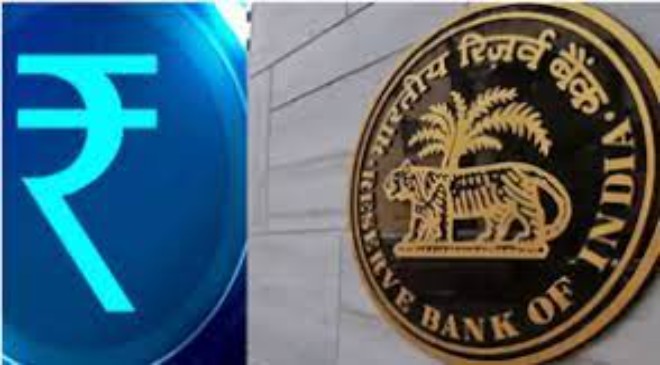The Reserve Bank on Tuesday said it will launch the first pilot for retail digital rupee (e₹-R) on December 1, 2022, in which four banks including SBI and ICICI Bank will initially participate.
On November 1, the RBI had launched the first pilot in the digital rupee – wholesale segment. Announcing the operationalisation of Central Bank Digital Currency Retail (e₹-R) Pilot, the RBI said the pilot would cover select locations in closed user group (CUG) comprising participating customers and merchants.
So, what is CBDC or India’s digital rupee?
The RBI defines it as digital legal tender. The digital rupee will be exchangeable at par with existing currencies and will be accepted for payments as well as a safe store of value, explains a report by Forbe.
CBDC, also known as the e₹-R or the digital rupee, is a new currency issued by the Reserve Bank of India that is similar to existing banknotes except that it is expected to be transacted digitally and facilitate ease of use.
The digital rupee is the RBI’s ‘accepted version of cryptocurrencies,’ the report explains, which the central bank has repeatedly dismissed as a serious threat to the country’s financial system’s stability.
Read More: Apple threatens Twitter with App Store ban, Elon Musk says he will go to war with Apple
Let’s also take a look at what cryptocurrency is and how the digital rupee will differ from it.
Cryptocurrencies
Cryptocurrency is decentralised money that is not bound by the chains of any government or central bank. It is based on blockchain technology and employs cryptography to secure human transactions, making them impossible to forge.
However, in August 2010, a hacker discovered a flaw in the Bitcoin protocol. By performing multiple transactions before logging them into the blockchain, the hacker exploited the vulnerability and generated an infinite amount of Bitcoins.
How is Cryptocurrency Created?
All cryptocurrencies are created through a laborious process known as mining. Miners use computers equipped with high-end GPUs to solve various complex mathematical problems and puzzles in exchange for cryptocurrencies.
People can also buy cryptocurrencies from currency owners and exchange platforms, as well as sell them to other people. Cryptocurrencies are kept in digital wallets, which can be hot or cold. A hot wallet has an internet connection. Cold storage, on the other hand, keeps your assets offline.
Cryptocurrencies, like UPI transactions, can be transacted or transferred using your smartphone. Users can also use their bank accounts or P2P transactions to convert their crypto holdings to cash.
Read More: Single Social Security Payment: Centre may allow small companies to merge PF, pension payments
What Has India Said on Crypto?
In 2018, people in India were warned that virtual currencies are not legal tender, the report by Forbes said. The finance ministry formed a committee to draught a cryptocurrency bill in India. However, the ban was overturned by the ministry.
In 2019, a bill prohibited cryptocurrency mining, holding, selling, issuing, transferring, and using. If found in violation of the law, people could face a hefty fine or up to ten years in prison. The Supreme Court of India lifted the ban in March 2020.
Finance Minister Nirmala Sitharaman raised the issue of cryptocurrency in the Rajya Sabha in November 2021. She stated that while the government has not taken concrete steps to prohibit cryptocurrency advertisements in India, it will raise awareness through the RBI and SEBI.
In the Union Budget 2022-23 – The Indian government recognised cryptocurrencies and decided to tax any virtual asset at 30%. That was when she also announced the creation of a CBDC known as the digital rupee.
Difference Between Cryptocurrency and the Digital Rupee?
In its note on the digital currency, the RBI had said, “a CBDC is a legal tender issued by a central bank in a digital form. It is the same as a fiat currency and is exchangeable one-to-one with the fiat currency. Only its form is different.”
“Unlike cryptocurrencies, a CBDC isn’t a commodity or claims on commodities or digital assets. Cryptocurrencies have no issuer. They are not money (certainly not currency) as the word has come to be understood historically,” said the announcement made by RBI.
The CBDC is a digital representation of paper currency issued by central banks such as the RBI, and it should be exchangeable for cash. The widely known digital rupee is a currency issued by the RBI, and the digital rupee will serve the same purpose, but it will not be a decentralised asset like cryptocurrencies. The digital rupee will be a currency issued by central banks who will be in charge of governing and managing the asset.
The digital rupee will be legal tender, which means it can be used to purchase goods and services. Digital rupees include things like digital wallets, NEFT, and IMPS. As a result, when the RBI begins to circulate the digital rupee, all Indian citizens will be able to use it.
Reasons RBI Listed for Starting CBCD
According to its note, this is why the government has started CBCD:
- Reduction in cost associated with physical cash management.
- To further the cause of digitisation to achieve a less cash economy.
- Supporting competition, efficiency, and innovation in payments.
- To explore the use of CBDC for improvement in cross-border transactions.
- Support financial inclusion.
- Safeguard the trust of the common man in the national currency vis-à-vis proliferation of crypto assets.





































